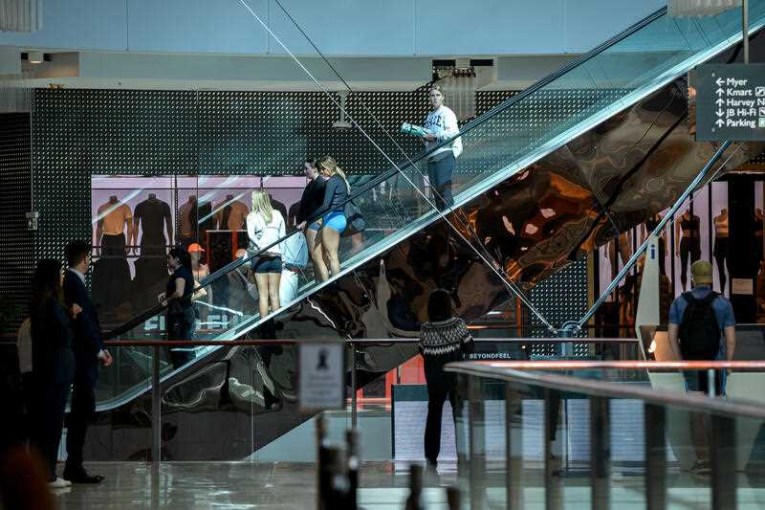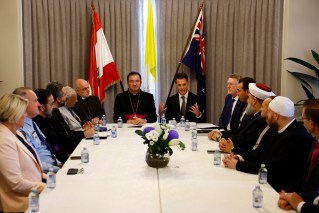‘A con’: Malcolm Turnbull blasts key part of government’s net-zero plan


Malcolm Turnbull addresses the Smart Energy Council Photo: supplied
Prime Minister Scott Morrison says his long-awaited net-zero plan will lower power bills, create 100,000 jobs, and leave Australians thousands of dollars better off by increasing the gross national income by 1.6 per cent.
But his predecessor Malcolm Turnbull has been scathing of a key pillar of the plan, calling carbon capture and storage – which the government is relying on to cut emissions in manufacturing and mining – as a “con” and “distraction” by the coal industry.

Scott Morrison announces the net zero plan.
“It is a proven failure and it keeps getting run up the flagpole by the fossil fuel sector as a way to defer action,” Mr Turnbull told The New Daily.
Mr Morrison will take the net-zero plan, and a projection that Australia will comfortably beat its Paris agreement goals, to Glasgow’s COP26 climate summit this week.
But Labor, the Greens and environmental groups are demanding more detail, with the government yet to release detailed modelling on the costs of the plan and how it will achieve emissions neutrality.
“This is a plan for the world that we know and where it’s heading,” Mr Morrison said.
The PM and Energy Minister Angus Taylor outlined their ‘Long-Term Emissions Reduction Plan’ on Tuesday, detailing how the Coalition forecasts it will reach net zero by 2050.
But government documents state clearly the plan shows only “how Australia will achieve 85 per cent of the emissions reduction necessary”, and that it is “based on our existing policies”.
That is, no new policy to reach net zero was announced.

The breakdown of sectors in government plans.
Instead, the government says 20 per cent of emissions reductions necessary to hit net zero have already happened; another 40 per cent will come from its already announced Technology Investment Roadmap; 15 per cent would come from “global technology trends”; and up to 20 per cent is planned to come from emissions offsets, such as carbon capture and storage (CCS) technology.
That takes the total to 85 per cent emissions reduction.
The final 15 per cent is anticipated to come from “further technology breakthroughs” in future, as technology gets more efficient.
But critics say the CCS reliance is not appropriate.
The government is leaning on carbon capture and storage to help lower emissions in the industry, mining and manufacturing sectors by up to 54 per cent, and in the land and offsets sectors by up to 278 per cent.
According to Geoscience Australia, the technology involves captured carbon emissions being “injected deep underground into geological formations”.
The government’s plan shows large “prospective” carbon storage locations nationwide, including in waters off Western Australia, Victoria and the Northern Territory.

“Prospective” carbon capture projects in the net zero plan.
But in a speech to the Smart Energy Council last week, Mr Turnbull – who lost his leadership over a climate and energy dispute – claimed carbon capture doesn’t work.
He said its mooted use in the production of ‘blue hydrogen’ fuel was “a scam and a con”.
“CCS is a proven failure,” Mr Turnbull said.
He said he investigated the technology when he was environment minister and concluded it wasn’t appropriate.
“It’s too complex and too expensive, but it is being used by the fossil fuel sector as a distraction and delay the end of burning coal and gas,” Mr Turnbull claimed.
“Billions were invested, but it has failed, other than in a few niche applications.”
Speaking to TND, Mr Turnbull said CCS “has not worked”.
“It simply costs too much and doesn’t capture enough of the C02,” he said.
“Time’s up.”
Tweet from @JoshButler
But the government’s plans say carbon capture is “essential” to reduce emissions in manufacturing, natural gas and heavy industry.
It spruiks more than $300 million in funds committed to carbon capture and storage hubs and technology.
“Low-cost abatement technologies do not yet exist for hard-to-abate sectors like steel, chemicals and cement,” the document says.
“It can also provide a pathway to produce clean hydrogen using natural gas or coal.”
Other criticisms of carbon capture came in thick and fast on Tuesday.
WWF Australia called it “a delaying tactic” that had “failed”; Greenpeace said it was a “dirty wish list of fantasy technology”; the Smart Energy Council too rubbished it as “fantasy”; while Climate Council economist Nicki Hutley said it was “unproven”.
The Australia Institute’s climate director Richie Merzian called carbon capture a “colossal failure”.
“This is a government trying to build its own ‘get out of jail card’, to allow its fossil fuel industry and big mining industry and big polluters to continue polluting,” he claimed.
CSIRO chief executive Dr Larry Marshall said in August that carbon capture had “the potential to have a significant impact” in lowering emissions.
The National Farmers Federation welcomed Tuesday’s carbon capture plans, saying it was a “tremendous opportunity … to use agricultural land as a carbon sink”.

How the government plans to reach net zero.
Smart Energy Council chief executive John Grimes also chided the government for assuming success from “technologies that don’t work or won’t happen”.
But Mr Morrison defended the plan’s key assumption that 15 per cent of reductions would come from new technology, saying such advances were “a given”.
“If we don’t think there’s been a rapid development in technology on handheld devices in the last 10 years then someone must have been living on a different planet,” he said as an example.
“It is probably one of the safest assumptions that you can make, that the rapid introduction of technology will continue to drive these costs down.”
The government is pouring $20 billion into low-emissions technology, hoping it will spark up to $100 billion in private investment and therefore drive tech advances.
Mr Morrison’s office later suggested tech advances could include hydrogen-fuelled boilers, more efficient solar panels and batteries, and improvements to animal feed to reduce livestock methane emissions.
The PM pledged to release the net-zero modelling “soon”, but political opponents demanded it be shared immediately.
Labor’s climate change spokesman, Chris Bowen, called it a “scam”.
“I’ve seen more detail in a fortune cookie than in documents released by the government today,” he joked.
“It requires leadership and detailed plans.”
Greens leader Adam Bandt accused Mr Morrison of a “climate fraud”.
“There’s no new money, no new policies, more coal and gas and 2030 targets that will cook our kids,” he claimed.








